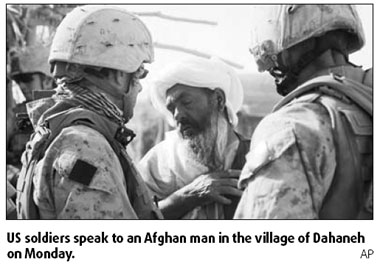
|
WORLD> Asia-Pacific
 |
|
Related
Afghan warfare gets wired in quest to spare lives
(China Daily)
Updated: 2009-08-19 15:13  FORWARD OPERATING BASE SPIN BOLDAK, Afghanistan: Sergeant 1st Class Gregory Henson goes out on patrol with a computer on his back and a joystick in his holster. He also carries a rifle, but the military is hoping he'll soon have less need for it. A wired generation of US soldiers is about to battle-test a high-tech weapon calculated to reduce civilian casualties in Afghanistan. A key component is the "Dragon Egg", a softball-sized robotic camera that can be thrown over a hill or into a building without endangering troops. It rights itself like a Weeble Wobble toy and delivers a 360-degree view through its four tiny cameras. If any innocents are in the area, the soldier can mark the spot using his backpack computer to ward off an air strike. "You don't have to enter a room. You don't have to worry about the first man in the room," said Sergeant Mike Fraser, who has been trained on the use of the cameras made by La Verne, California-based Octatron Inc. The idea is to bring down the Afghan civilian death rate, which is stoking public anger and draws denunciations from President Hamid Karzai after each incident.
With the new technology, "we can put a no-fire area over a mosque or a school," said Colonel Harry Tunnell, commander of the 5th Stryker brigade that deployed to southern Afghanistan this summer as part of the 21,000 additional US troops ordered in by President Obama. The Ft. Lewis, Washington-based brigade is putting the computer system, called "Land Warrior" by manufacturer General Dynamics, into its first large-scale use in Afghanistan, distributing it to vehicle commanders or other team leaders, meaning it will be carried by about one in every five or seven soldiers in the brigade of more than 5,000 people. Each combat platoon of a few dozen soldiers will all receive a Dragon Egg kit. Land Warrior comes with a viewfinder that drops over a soldier's eye and displays an aerial map marked with roads and towns, along with icons designating hostile forces and civilians. Soldiers pinpoint locations with satellite data and type notes into the system using a thumb keyboard that looks like the sliced-off bottom half of a Blackberry. Satellite and radio links then spread the data between Stryker assault vehicles, aircraft and foot soldiers wearing the computers. If a soldier marks a vehicle or a house, it is seen instantly by anyone else in the brigade who has the system. It isn't perfect. Too much information can swamp the computer screens, for instance when blue dots that pinpoint a US force's whereabouts become so numerous that they merge into one large dot - a "blue booger" in soldiers' parlance. Also, the computer adds 3.6 kg to a soldier's standard 20 to 25 kg of equipment. But Lieutenant Sam Bonnette says he likes "that I know where my guys are at on the ground." Some soldiers are retrofitting the gear, sticking computers designed to sit inside body armor into backpacks so they can swing on and off easily. AP |